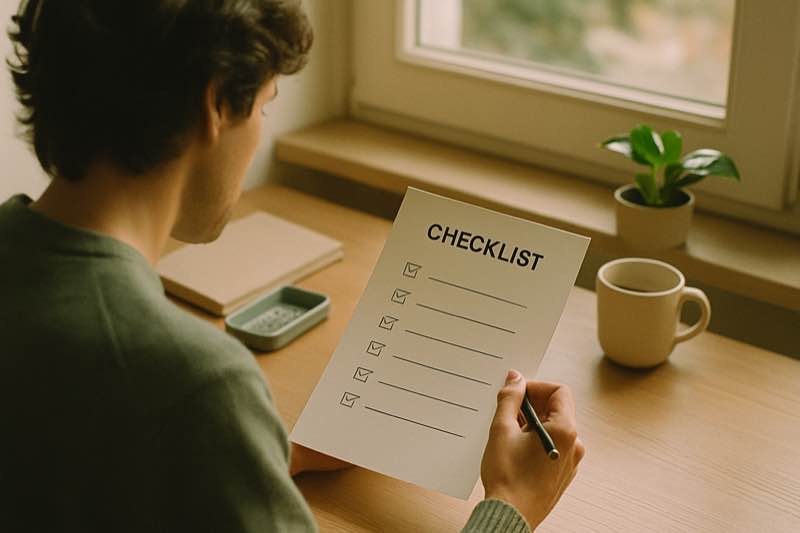ADHD Productivity & Task Management Strategies for Adults
Traditional productivity advice often fails for adults with ADHD because it assumes neurotypical executive function. Instead of "just focus harder," successful ADHD productivity relies on external structure, accountability systems, and brain,friendly workflows that work with your neurodivergent strengths.
ADHD productivity strategies include creating structure, breaking tasks into smaller steps, and using external tools like body doubling and planners. These methods help bypass executive function challenges and make daily life more manageable.
You can start with a comprehensive self-assessment to organize your thoughts before meeting a professional.

Why Traditional Productivity Fails for ADHD
Adults with ADHD struggle with executive function skills—planning, prioritizing, task initiation, and working memory. Productivity systems designed for neurotypical brains often depend on these exact skills, creating a frustrating cycle of failure.
The ADHD Brain Difference
Evidence-Based ADHD Productivity Strategies
These strategies have been validated through research and real-world success with thousands of adults with ADHD.
Core Productivity Methods
| Option | Description |
|---|---|
| Body Doubling | Working alongside another person (virtually or in,person) provides accountability and focus without conversation |
| Task Chunking | Breaking large projects into small, specific actions that can be completed in 15,30 minutes |
| Timeboxing | Dedicating specific time blocks to tasks, creating urgency and preventing endless tweaking |
| Habit Stacking | Linking new tasks to existing habits, reducing the mental effort required to remember new behaviors |
| External Brain Systems | Using calendars, apps, and visual reminders to replace unreliable working memory |
| Dopamine Hacking | Building in immediate rewards and variety to sustain motivation for boring but important tasks |
The Power of Body Doubling
Body doubling is often called the simplest and most effective productivity booster for adults with ADHD. Even silent company provides enough accountability to spark focus.
How to Use Body Doubling Effectively
Choose Your Format
Try in,person coworking, virtual body doubling sessions, or even working while on video calls with friends or colleagues.
Set Clear Boundaries
Establish that this is work time, not social time. Minimal conversation helps maintain focus for both parties.
Find Consistent Partners
Regular body doubling partners create accountability and routine. Many ADHD communities offer body doubling sessions.
Start Small
Begin with 25,50 minute sessions. As your focus improves, you can extend the time or add more sessions.
Task Management That Actually Works
Traditional to,do lists often overwhelm ADHD brains. These alternatives provide structure without cognitive overload.
The Two,Minute Rule Plus
ADHD,Modified Task Management
Capture Everything
Write down all tasks immediately in one trusted system. Don't rely on memory,it will fail you.
Two,Minute Rule
If a task takes less than two minutes, do it immediately rather than adding it to your list.
Chunk Larger Tasks
Break any task longer than 30 minutes into specific, actionable steps that feel manageable.
Priority by Energy
Match task difficulty to your current energy level rather than arbitrary importance rankings.
Visual Progress Tracking
Use checkboxes, progress bars, or visual systems to see accomplishments and maintain motivation.
Essential Productivity Tools
| Option | Description |
|---|---|
| Digital Planners | Todoist, Asana, or Notion for visual task management with recurring reminders and project breakdown |
| Time Management | Pomodoro timers, Forest app, or Be Focused for structured work sessions with breaks |
| Note,Taking | Obsidian, Roam, or simple voice memos for capturing thoughts without losing momentum |
| Calendar Systems | Google Calendar with color coding, multiple alarms, and time,blocking for focused work |
| Focus Enhancement | Noise,canceling headphones, Brain.fm, or white noise apps to create optimal work environments |
| Physical Tools | Whiteboards, sticky notes, fidget toys, and standing desk options for kinesthetic learners |

Building ADHD,Friendly Daily Routines
Routines reduce decision fatigue and create structure that supports executive function. The key is starting small and building gradually.
Morning Routine Framework
ADHD Morning Routine Building
Prepare the Night Before
Set out clothes, prepare breakfast, and write tomorrow's top three priorities to reduce morning decisions.
Create Visual Reminders
Use phone alarms, sticky notes, or apps to prompt each step of your routine until it becomes automatic.
Stack Habits
Link new habits to existing ones: 'After I brush my teeth, I'll review my daily priorities.'
Build in Flexibility
Allow extra time for ADHD time blindness and include 'buffer time' for unexpected delays.
Include Dopamine Hits
Add enjoyable elements like favorite music, preferred coffee, or brief social media time as routine rewards.
Workplace Productivity Strategies
ADHD can be a hidden challenge in traditional workplaces, but specific strategies can dramatically improve performance.
Office Environment Optimization
| Option | Description |
|---|---|
| Noise Control | Request quiet workspaces, use noise,canceling headphones, or negotiate work,from,home options |
| Meeting Management | Ask for agendas in advance, bring fidget tools, request written follow,ups to verbal instructions |
| Communication Systems | Use email for important instructions, set up regular check,ins with supervisors, clarify expectations |
| Schedule Flexibility | Negotiate flexible hours to work during peak focus times, take movement breaks, adjust deadlines when possible |
| Task Organization | Request project breakdowns, use visual project management tools, get clarification on priorities |
| Technology Support | Use calendar alerts, task management apps, and reminder systems to stay on track |
Managing ADHD Energy Cycles
Working with ADHD Energy Patterns
Track Your Energy
Monitor when you're most focused and alert during the day. Most people with ADHD have clear peak performance times.
Schedule Strategically
Block your best hours for complex tasks. Save routine or less demanding work for lower,energy periods.
Honor Your Rhythms
Don't fight your natural patterns. If you're a night owl, negotiate later start times when possible.
Plan for Low,Energy Days
Have a list of simple tasks ready for days when focus is particularly challenging.

Overcoming Common ADHD Productivity Obstacles
Understanding typical challenges helps you prepare strategies rather than feeling defeated when they arise.
Procrastination and Task Initiation
| Option | Description |
|---|---|
| The 5,Minute Rule | Commit to working on a task for just 5 minutes. Often, starting is the hardest part. |
| Task Pairing | Combine boring tasks with enjoyable activities, like listening to music while organizing files |
| Environmental Changes | Change your location, time of day, or work setup to create fresh mental associations with tasks |
| Accountability Partners | Schedule work sessions with others or commit to deadlines with people who will follow up |
| Reward Systems | Set up immediate rewards for starting and completing tasks, not just for perfect performance |
| Reduce Friction | Remove barriers to starting: keep materials ready, minimize setup time, eliminate decision points |
Technology and Apps for ADHD Productivity
The right technology can serve as an external executive function system, but avoid app overload.
Creating Sustainable Systems
The best ADHD productivity system is one you'll actually use consistently. Focus on sustainability over perfection.
Building Systems That Stick
Start Ridiculously Small
Choose one tiny habit or system change. Success with small changes builds confidence for bigger improvements.
Test and Adjust
Try new systems for 2,3 weeks before deciding if they work. ADHD brains need time to adapt to new routines.
Plan for Setbacks
Expect occasional system failures. Build restart mechanisms rather than abandoning systems entirely.
Regular Reviews
Schedule weekly or monthly reviews to assess what's working and what needs adjustment.
Celebrate Progress
Acknowledge improvements, even small ones. ADHD brains need positive reinforcement to maintain motivation.
Quick Wins to Try Today
Start improving your productivity immediately with these evidence,based strategies:
| Option | Description |
|---|---|
| Two,Minute Rule | Do any task that takes less than 2 minutes immediately instead of adding it to your to,do list |
| Phone Timer Method | Set a 15,minute timer for focused work on one task, then take a 5,minute break regardless of progress |
| Evening Planning | Write down tomorrow's top 3 priorities before bed to reduce morning decision fatigue |
| Visual Progress | Use a simple checklist or progress bar to track completion of multi,step projects |
| Body Doubling Session | Join a virtual coworking session or work alongside a friend for increased accountability |
| Energy,Task Matching | Do your most challenging task during your peak energy time (usually morning for most people) |
You can start with a comprehensive self-assessment to organize your thoughts before meeting a professional.
Common Questions About ADHD Productivity
What's the best productivity method for ADHD?
No single method works for everyone with ADHD. The most successful approaches combine external structure (timers, reminders), accountability (body doubling, check,ins), and work with your natural energy patterns rather than against them.
Why do productivity apps stop working for me?
ADHD brains crave novelty, so systems that work well initially may lose effectiveness. This is normal. Rotate between systems, modify existing ones, or build variety into your routines to maintain engagement.
How do I stay motivated with boring tasks?
Boring tasks are kryptonite for ADHD brains. Try pairing them with stimulating elements (music, timers, rewards), breaking them into tiny chunks, or using body doubling to add social accountability.
Key Takeaways
ADHD productivity thrives on external structure, not just internal motivation. The most effective strategies work with your brain's natural patterns rather than fighting against them.
Remember: , Start with one small system and build gradually , External accountability is more reliable than willpower alone , Perfect productivity doesn't exist,focus on consistent improvement , Your peak energy times are productivity gold,protect and use them wisely
If you're struggling with focus and productivity issues that might be related to ADHD, take our free screening assessment to better understand your experiences and explore professional evaluation options.
This article provides educational information only and does not replace professional medical advice. For individualized productivity strategies and ADHD management, consult with a licensed healthcare provider or certified ADHD coach.
